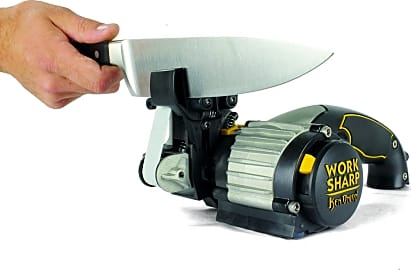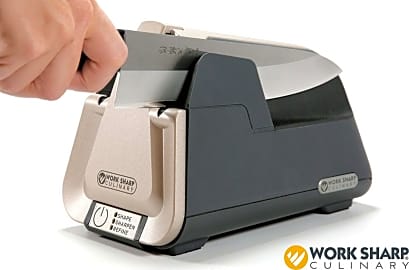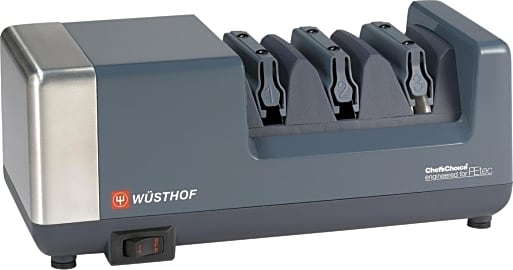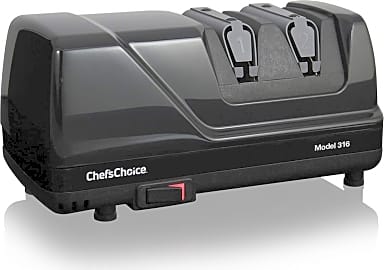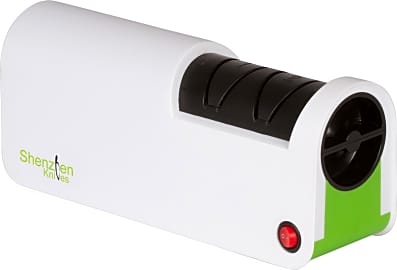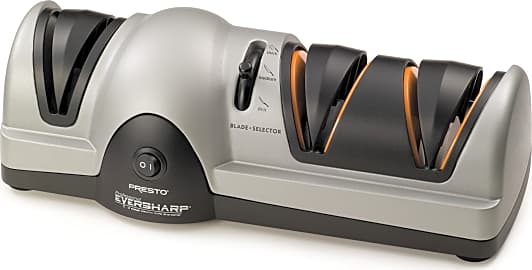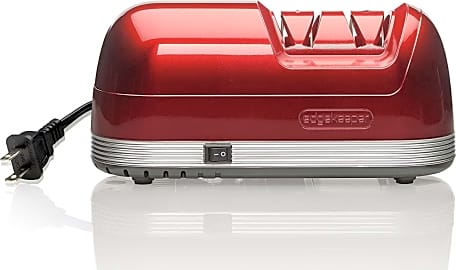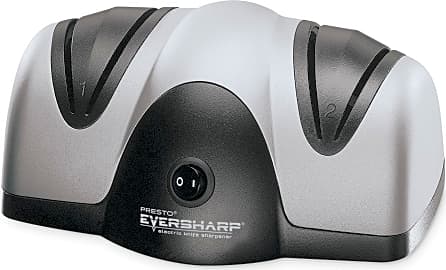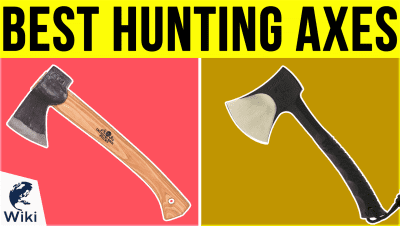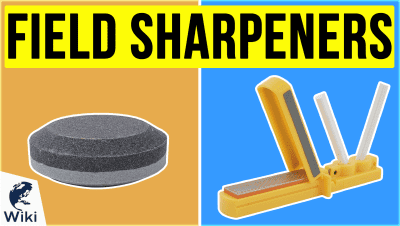The 10 Best Electric Knife Sharpeners

This wiki has been updated 41 times since it was first published in April of 2015. If you want to chop, dice and slice easily and quickly, you have to keep your blades sharp. Both amateur and professional chefs will appreciate these electric knife sharpeners, which can bring an edge back to new condition or, in many cases, surpass it. They will not only save you time, but can also protect your expensive tools from damage by ensuring clean and consistent metal removal. When users buy our independently chosen editorial selections, we may earn commissions to help fund the Wiki.
Editor's Notes
November 03, 2020:
There is a popular saying among professional chefs that the most dangerous thing in a kitchen is a dull knife. While this may seem counter intuitive, it actually makes a lot of sense when you really think about it. A dull knife requires a lot more pressure to cut through foods, and the more pressure you put behind a blade, the more likely it is to slip and cut something you don't want to, like your finger. Not only is a dull knife more prone to slipping, when that does inevitably happen, there will be a lot more force behind it, which results in a deeper cut that what you probably would get if you slipped using a very sharp knife without a lot of force behind it. Because of this, we recommend keeping your blades in tip top shape using one of the sharpeners on this list.
Not only is the Chef's Choice XV Trizor one of our favorite choices, but it was even named the best electric knife sharpener by America's Test Kitchen. In their tests, they found that it produces a sharper and finer edge than most high-quality knives receive at the factory, so rather than making your favorite chef knife feel like new again, it can make it feel even better. Not far behind the XV Trizor in their tests was the Chef’s Choice 316 Diamond, though it should be noted this only has a two-stage process versus the three stages of the XV Trizor. It should also be noted that both of these will give your blade a 15-degree bevel, so if you don't want this, you should look elsewhere.
The Chef's Choice 250 Hybrid produces a 20-degree bevel, which those used to old European knives may prefer, and it even features a manual stage with an ultra-fine grit to really smooth out the edge of the blade. It is quite reasonably priced too, making it a good choice for those on a tight budget.
When it comes to versatility, the Work Sharp Ken Onion Edition is a standout model. It allows you to adjust the angle of the bevel from 15 to 30 degrees, making it suitable for pretty much every type of blade out there, from a burly hunting ax to a delicate [pairing knife](knives).
May 17, 2019:
A sharp knife is not just more effective but also safer than a dull one, hands down. Presto makes a couple affordable electric sharpeners that won't be an eyesore in the kitchen, though if you're not concerned about the unit's appearance, but only its functionality, the Chef's Choice 250 Hybrid is probably the top inexpensive choice. If you are into looks, though, the EdgeKeeper is hard to beat, with its retro-futuristic design. The Shenzen is another affordable option, and one of its interesting features is the magnetic particulate collector that will help keep your workspace clean. The Wusthof is the ideal workhorse and can stand up to intense duty cycles, while the top Chef's Choice is the most popular wheel-type model. The Work Sharp E5 is an interesting choice because it's a reasonably priced and sized blade-driven model. Because belts move more slowly than blades, a lot of avid knife users feel that they do less damage to an edge and allow the knife to remain effective for longer. In that same vein, the Ken Onion model (bearing the name of a popular chef who now markets knives and knife-related tools) is an all-around wildly effective choice. Do keep in mind, though, that belt-driven models generally require more attention to detail and more hand control and aren't necessarily the best for novice users.
Finally -- and I can't stress this enough -- after you settle on an electric knife sharpener, head over to our list of honing steels and grab one of those, preferably a smooth stainless model. Honing is the step that's supposed to follow sharpening; after a sharpener removes a bunch of metal and returns a blade to good condition, a honing rod turns micro-serrations and inconsistent finishes into uniform lines and true edges. If you want your knives to stay sharp as long as possible and respond well to maintenance for a long time, there are two rules you must follow: DO NOT oversharpen, and ALWAYS properly hone when you're finished.
Special Honors
Edlund 401 If you have a commercial kitchen, you need an NSF-certified model like the Edlund 401. Its ABS plastic guides are easy to remove for cleaning, and just as easy to re-install, so they won't harbor bacteria, and its grinding wheel is replaceable as needed. It can handle both thin, delicate knives and thick, heavy cleavers. edlundco.com
Tormek T-2 Though it is overkill for the average home kitchen, if you run a high-volume restaurant and don't want to pay for an outside service, or simply want to make the lives of your chefs who are required to care for their own blades a little easier, the Tormek T-2 can be a good choice. It has one diamond wheel for sharpening and a composite one for polishing, and it is equipped with a guidance system that gives the operator full control over their bevel. tormek.com
The Knife: Every Chef's Most Important Tool
Most kitchen workers and home cooks swear by them as their most treasured piece of equipment.
Most culinary professionals will agree: few tools get as much use in the kitchen as the iconic chef's knife. These medium-to-large-sized beauties are often flashy and usually razor-sharp. Most kitchen workers and home cooks swear by them as their most treasured piece of equipment. And when something is that important to your food and your career, keeping it in great condition is of utmost importance.
The most obvious reason for proper knife care is the ease with which a sharp knife can be used. The most exact, clean, consistent cuts are easy when your blade sinks smoothly into the food you're prepping. What a lot of people overlook is the safety factor that comes with keeping your implements in tip-top shape.
It's simple to see how a dull knife is more dangerous than one that is honed daily. It takes more power to chop with a blunted blade, and inconsistent knife edges easily slip off food and can jerk the knife across or into your hand accidentally. Furthermore, injuries from less-than-perfect knives generally take longer to heal. So, it's of prime importance to keep that blade as keen as possible.
The thing is, sharpening knives using the popular and traditional sharpening stone method can be very difficult. Many cooks spend years of careful practice perfecting this skill. However, barring a prodigy-level ability to quickly master this ancient technique, there are other options, such as professional sharpening services. But it does generally take multiple knives to get various jobs done, and the prices from these craftsmen can add up quickly, especially if you have a lot of dull knives.
So what does the home chef or restaurant sous do to make sure every metal tool is safe and effective without breaking the bank? Leave it to modern power tools to bring us a quick, easy, and foolproof way to maintain any set of knives.
What It Means To Be Sharp
That's a great question — and one that's often left unanswered. First of all, sharpening and honing are two different activities. Before a blade becomes actually dull, first it loses its true. In this stage, the very edge of the knife actually becomes malleable and curls over slightly, hurting the knife's overall performance. When this happens, as it does to all knives during regular use, the correct solution is to use a honing rod.
In this stage, the very edge of the knife actually becomes malleable and curls over slightly, hurting the knife's overall performance.
While sharpeners remove material from the blade and can make an unusable knife seem new again, honing rods simply uncurl the very edge of the knife and keep it from starting to become dull. That being said, many heavily-used knives will benefit from a monthly sharpening in addition to daily honing. And that's just the beginning of understanding sharpness.
There are a few qualities that affect exactly how sharp your knife blade will be. Be careful to remember that not all steel is the same. Indeed, manufacturers use very different alloys with varied qualities that directly effect how the knife is used. Many knives, especially those with German or French heritage, use steel that is somewhat heavy and soft when compared to the metal used in most Japanese-style knives.
Although this is somewhat counterintuitive, soft, heavy steel is often more resilient to nicks and dulling than harder steel. Carbon steel, known for the high level of attention and care it demands, actually holds a better edge and is more easily sharpened than its stainless counterpart. On the other hand, while harder alloys require less daily honing, some high-hardness steel can become brittle and prone to chipping. For example, it's important to use only smooth honing rods on harder Japanese-style knives to prevent micro-serrations that diminish the edge and lifespan of the blade.
What These Tools Can Do For You
As mentioned, hand-sharpening knives is by no means an easy task to get right. It requires investment in a set of stones of varying coarseness, patience, and lots of practice. In fact, a lot of people end up damaging a knife or two while learning the process, so its good not to start training on your finest European blade. With the advent of high-quality electric options, though, that learning curve is effectively eliminated.
A few of them employ proprietary alloys that are just slightly less abrasive than the diamond wheels.
You'll find that most of the models on the market operate using at least one pair of grinding wheels. These are often made of industrial diamond-incorporated materials that work very effectively. A few of them employ proprietary alloys that are just slightly less abrasive than the diamond wheels. Some premium options use a belt-grinder setup with belts available in various grits. A couple high-end models even feature adjustable bevel guides. This lets you customize the exact angle of your blade's edge, perfect for chefs who use a blend of Eastern and Western-style knives of varying hardness.
A lot of these units offer multiple stages of grinding options. As the fineness of the wheel used increases, so does the sharpness and consistency of the blade, even on a microscopic level. For that reason, properly sharpened and honed blades tend to remain sharp and usable for longer stretches than knives that are only kept up sporadically.
Rarely, you'll run into a sharpener with a slot for serrated blades. This is especially useful, as the hand-sharpening of these useful tools is notoriously difficult and time-consuming. After all, a sharp serrated knife can be a huge help in the kitchen, especially when slicing homemade bread or extremely ripe heirloom tomatoes.
Many electric sharpening units are designed with kitchen knives in mind. Some of them are suitable not just for culinary applications, but also for working on hunting and survival equipment or brush-management tools. Of course, you'd never want to be caught with a dull pocketknife when field-dressing a buck or building an emergency shelter. With today's wide range of available electric knife sharpeners, you never will be.



